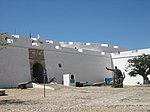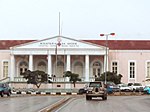Estádio dos Coqueiros
Angolan building and structure stubsAngolan sport stubsBuildings and structures completed in 2005Buildings and structures in LuandaCentral Africa sports venue stubs ... and 2 more
Football venues in AngolaSport in Luanda
Estádio dos Coqueiros is a multi-use stadium in Luanda, Angola. It is currently used mostly for football matches and is the home ground of Benfica de Luanda and Kabuscorp. The stadium holds 12,000 people and was built during the colonial period, in 1947. It underwent major renovation works in 2005.
Excerpt from the Wikipedia article Estádio dos Coqueiros (License: CC BY-SA 3.0, Authors).Estádio dos Coqueiros
Rua dos Coqueiros, Luanda Kinanga
Geographical coordinates (GPS) Address External links Nearby Places Show on map
Geographical coordinates (GPS)
| Latitude | Longitude |
|---|---|
| N -8.814293 ° | E 13.226014 ° |
Address
Estádio Municipal dos Coqueiros
Rua dos Coqueiros
Luanda, Kinanga
Luanda Province, Angola
Open on Google Maps









